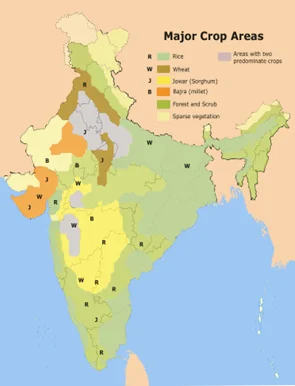Answer:
| Approach:
Introduction
- Define cropping pattern and give a brief about the current cropping pattern.
Body
- Mention changes in the cropping pattern.
- Talk about millets and the reasons for recent focus on millets.
Conclusion
- Conclude stating that crop diversification has several benefits and even among these, the role of millets is crucial for food, nutritional and environmental security.
|
Introduction:
Cropping pattern is the proportion of area under various crops at a point of time. The cropping patterns of a region are mainly influenced by the geo-climatic, socio-economic, historical and political factors.

Body:
Changes in cropping pattern:
- Green revolution: Post Green revolution, Paddy, wheat, cotton, soybean, and sugarcane have come to cover more than half of total sown area.
- Monoculture: Rice-wheat system have taken over the area traditionally devoted to millets, oilseeds and pulses which were more suited to the local climatic and soil conditions.
- Degradation of agricultural land: Due to improper cropping pattern, soil fertility has declined and groundwater has receded. Chemical pollution and impacts on human health are the direct manifestations of this change in crop patterns.
- Increase in irrigated agriculture: The emphasis on certain crops has led to an increase in irrigated agriculture as these crops require more water and nutrients than traditional crops.
- Promotion of horticultural crops has increased as part of improving nutritional security and to increase farmers income.
Recently, focus on pulses and millets has been revived due to changes in consumer preferences, water scarcity and environmental degradations caused by the negative effects of the green revolution.
Millets are a group of crops comprising sorghum (Jowar), pearl millet (Bajra), finger millet (Ragi/Mandua) and small millets viz; little millet (Kutki), Kodo millet (Kodo), barnyard millet (Sawa/Jhangora). They are now called as ‘NutriCereals’ due to their high nutritive value.
The Food and Agriculture Organization of the United Nations (FAO) has declared 2023 as the International Year of Millets. The focus given on production and consumption of millets can be explained as follows:
- Climate Resilient Staple Food Crops: Millets are drought-resistant, require less water and can grow in poor soil conditions. This makes them a suitable food crop for areas with unpredictable weather patterns and water scarcity.
- Short duration crops: Their short growing season (65 days) makes them commercially sound as multiple crops can be grown.
- Rich in nutrients: Millets are a good source of fibre, protein, vitamins, and minerals. They tackle widely prevalent nutrition deficiency, particularly micronutrient deficiency.
- Gluten-free: Millets are naturally gluten-free, making them suitable for people with celiac disease or gluten intolerance.
- Adaptable: Millets can be grown in a variety of soils and climates, making them a versatile crop option for farmers.
- Sustainable: Millets are often grown using traditional farming methods, which are more sustainable and environmentally friendly than modern, industrial farming practices. In the event of Climate change, they will be crucial for regional Food and Water security.
- Lifestyle change: With lifestyle diseases running rampant, millets have returned as a viable option to live a healthy life. Various States have been distributing millets such as bajra, jowar and ragi through the PDS.
Conclusion:
India’s Millet Revolution is driven by growing awareness of the health and environmental benefits of millets, as well as efforts to revive traditional agricultural practices and support small-scale farmers.
